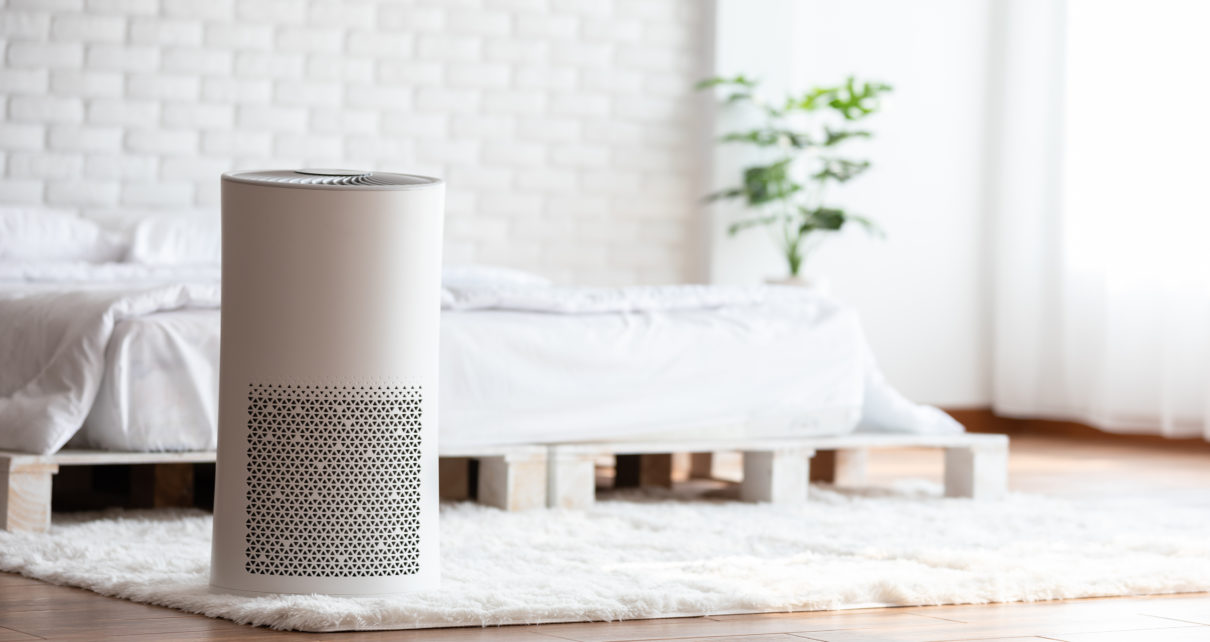
While a whole-home humidifier will certainly remedy the issue of dry air, these systems can be prohibitively expensive. They might also not be practical if you tend to spend your time in just a few rooms in the house, like the bedroom or living room. In this case, a portable humidifier might be just what you need. One of the most frequent questions about air purifiers is: “Is the best place to put a humidifier in the bedroom or living room?” Today we’re going to answer that question.
Humidity refers to the amount of moisture in the air and it can affect everything from your skin to your respiration. When humidity is too low – as tends to happen in winter — you’re more likely to experience dry skin, chapped lips, sore throat, and sinus congestion. One of the simplest ways to raise humidity and resolve these issues is to purchase a humidifier.
Tips for Choosing a Humidifier: Best Options
Humidifiers come in a wide range of sizes, all with different features. Before deciding whether to keep your humidifier in the bedroom or living room, it’s worth learning a little more about how these devices work so you can make an educated decision.
When it comes to portable humidifiers, the most common options are:
Evaporators
These units utilize a fan to blow moisture through a moistened filter. They are affordable but come with a risk of increasing the humidity too much in your home.
Impeller Humidifiers
A very child-friendly option, impeller humidifiers use rotating disks to create cool mist.
Steam Vaporizers
These humidifiers are powered by electricity, heating water before cooling it to expel moisture into the air.
Ultrasonic Humidifiers
One of the safety options, this humidifier uses ultrasonic vibration to produce a warm or cool mist.
Once you’ve chosen the type that suits your needs, think about the size of the model as well as any features you’d like. Most portable humidifiers are small enough to place wherever you like, but it’s important to choose one large enough for the size of your room.
Additional features you might consider include the option to add essential oils, a large water reservoir, and safety features like an automatic shutoff.
Benefits of Humidifiers for Bedrooms
Low humidity in the bedroom can cause you to wake with a sore throat, sinus congestion, and a cough. While these symptoms may fade throughout the day, they’ll only come back again after a night breathing in dry air. A bedroom humidifier can help you avoid these symptoms entirely so you enjoy a more comfortable and restful night’s sleep.
The most important thing to consider when buying a humidifier for the bedroom is room size. If you use a model that’s too large, it could increase humidity levels too high. Not only can this worsen respiratory problems but it could contribute to mold. The best spot to place a humidifier in the bedroom is on a side table near your bed.
Benefits of Humidifiers for Living Rooms
If you’re looking for a location to place a humidifier so the entire family can enjoy the benefits, the living room is a great option. Using a humidifier in shared spaces helps boost the moisture in indoor air which may reduce the chances of transmitting cold and flu.
Again, it’s essential to purchase a humidifier the right size for your living room. Small living rooms will not require a humidifier as large as open floor plan living rooms or living rooms with vaulted ceilings. Place the humidifier somewhere it can distribute moisture evenly but avoid putting it near a heating vent or register.
Which Option is Best?
In the end, it really comes down to where you need a humidifier most. If you don’t tend to spend most of your day in one room, it may be best to place your humidifier in the bedroom. If you experience more symptoms of low humidity during the day than at night, it makes sense to place it in the living room or wherever you spend the most time.
When choosing a location for your humidifier, there are a few practical things to consider. You should not place the humidifier on the floor – the higher you place it, the better. If you’re using it in a carpeted room, it’s best to check the carpet once in a while to make sure they’re not getting damp. Damp carpeting can become an ideal environment for mold.
Bottom Line
The best place to put a humidifier is the location in which it is likely to benefit you most. If you struggle with breathing problems at night or wake up with a sore throat, the bedroom might be the best option. If daytime symptoms are more concerning, consider the living room.
Honestly, if low indoor humidity levels affect you significantly, it’s worth considering a humidifier for both. These units don’t have to be expensive and they’re typically small enough to place out of the way on a table or countertop.
